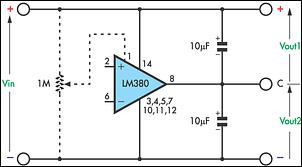Home » Circuits
Low-Cost Dual Power Supply
This circuit shows how to symmetrically split a supply voltage using a minimum of parts - one LM380 power amplifier plus two 10µF capacitors. It was originally published in National Semiconductor's AN69 and provides more output power than a conventional general-purpose op amp split power supply. Unlike the normal power zener diode technique, the LM380 circuit does not require a high standby current to maintain regulation. In addition, with a 20V input voltage (ie, for ± 10V outputs), the circuit exhibits a change in output voltage of only about 2% per 100mA of unbalanced load change. Any balanced load change will reflect only the regulation of the source voltage, Vin.Circuit diagram:
The theoretical plus and minus output tracking ability is 100% since the device will provide an output voltage at one-half of the instantaneous supply voltage in the absence of a capacitor on the bypass terminal. The actual error in tracking will be directly proportional to the unbalance in the quiescent output voltage. An optional 1MO potentiometer may be installed with its wiper connected to pin 1 of the LM380 IC to null any output offset. The unbalanced current output is limited by the power dissipation of the package.
In the case of sustained unbalanced excess loads, the device will go into thermal limiting as the internal temperature sensing circuit begins to function. And for instantaneous high current loads or short circuits, the device limits the output current to approximately 1.3A until thermal shutdown takes over or the fault is removed. For maximum output power (2.5W), all ground pins (3-5 & 10-12) should be soldered to a large copper area (the LM380 data sheet contains more details).

